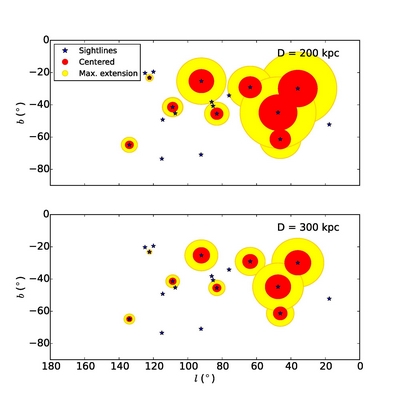A population of high-velocity absorption-line systems residing in the Local Group (Bouma et al.)
- Details
- Published on 26 June 2019
Vol. 627
In section 4. Extragalactic astronomy
A population of high-velocity absorption-line systems residing in the Local Group
 Intermediate and high-velocity clouds have remained a knotty problem for decades. The authors suggest that although a portion of the known clouds are bound to the Milky Way or connected with the Magellanic Stream, a subset are situated in the diffuse intergalactic medium of the Local Group. The novelty of the approach is the division of the clouds relative to the Local Group barycenter. The sample of 29 lines of sight toward a set of Hubble Space Telescope Legacy program AGNs has about twice the number of detections toward the barycenter as the opposite hemispheres. The authors use a range of ionizations (e.g., two for carbon, three for silicon), and 21 cm H I maps. These thermal properties are used to obtain distances by assuming they are in pressure equilibrium within model hydrostatic Galactic halos and by adopting several background radiation fields from the Galaxy and the Local Group (and beyond) to compute abundances and number densities with photoionization modeling. They thus derive
distances, masses, and sizes for the clouds. The column densities, converted to number densities, indicate that the clouds toward the barycenter have a range of about two orders of magnitude in density, while those toward the anticenter span less than a factor of ten and do not contain the low-density subset (about 1/3 of the sample) of the opposite direction. The cloud masses toward the barycenter are about 10^5 M_odot, with sizes of the order of a few hundred kpc. The authors argue that the low-density, high-velocity clouds are located beyond the Galactic virial radius and within unconfined gas of the Local Group.
Intermediate and high-velocity clouds have remained a knotty problem for decades. The authors suggest that although a portion of the known clouds are bound to the Milky Way or connected with the Magellanic Stream, a subset are situated in the diffuse intergalactic medium of the Local Group. The novelty of the approach is the division of the clouds relative to the Local Group barycenter. The sample of 29 lines of sight toward a set of Hubble Space Telescope Legacy program AGNs has about twice the number of detections toward the barycenter as the opposite hemispheres. The authors use a range of ionizations (e.g., two for carbon, three for silicon), and 21 cm H I maps. These thermal properties are used to obtain distances by assuming they are in pressure equilibrium within model hydrostatic Galactic halos and by adopting several background radiation fields from the Galaxy and the Local Group (and beyond) to compute abundances and number densities with photoionization modeling. They thus derive
distances, masses, and sizes for the clouds. The column densities, converted to number densities, indicate that the clouds toward the barycenter have a range of about two orders of magnitude in density, while those toward the anticenter span less than a factor of ten and do not contain the low-density subset (about 1/3 of the sample) of the opposite direction. The cloud masses toward the barycenter are about 10^5 M_odot, with sizes of the order of a few hundred kpc. The authors argue that the low-density, high-velocity clouds are located beyond the Galactic virial radius and within unconfined gas of the Local Group.

